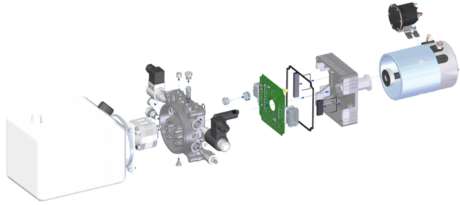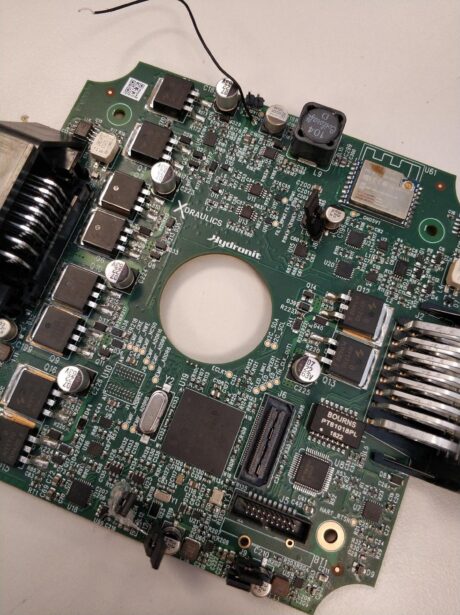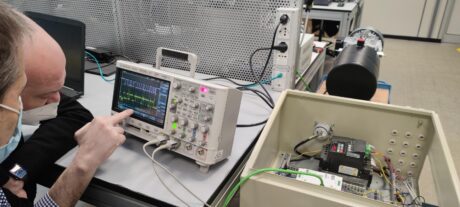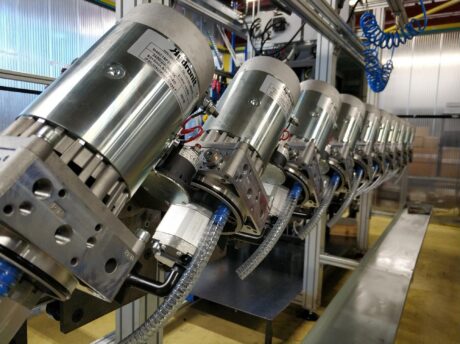Mechatronics and hydraulics together: the Smart Power Unit
The global market of hydraulic equipment represents a quite fragmented and competitive panorama. There are companies exclusively specialized in the development of hydraulic power units, whereas others – the so-called “system integrators” – offer electronic control solutions for its adjustment. However, to meet the requirements of the industry that increasingly shifts towards a model 4.0, power functions are often integrated with electronic control elements – PLC and software – to succeed in creating automation around the power part. This implies the combination of components that derive from different manufacturers and that are not necessarily designed to work together, sometimes causing the failure of hydraulic machines.
Why not thinking, then, also for hydraulic power units, of creating a product that joins the electronic part with the power part since their design, so implementing a compact single “All in One” unit, granting user-friendliness and easy programming?
This is precisely what the Italian company Hydronit has done, in the context of a European project – Midraulics – funded in the ambit of Horizon 2020.

Hydronit was established in 2003 and is specialized in the manufacturing of compact modular hydraulic mini-central units. «Not relying on a central unit that combines power with control electronics means turning to a system integrator to integrate different components – power unit, PLC and sensors and to a programmer to programme the PLC. We have designed and implemented a central unit called Smart Power Unit (SPU) where we invented nothing new, because PLC, software, sensors and central units already existed. The novelty of our product consists in having joined all these components – control power, sensors and software in a single integrated package» states the engineer Andrea Gambusera, CEO of Hydronit. The addition of electronics, sensors and calculation to the power unit makes up a mechatronic system. «The first hydraulic mechatronic system par excellence was the anti-lock braking system (ABS) that today is a standard in each car. Precisely as ABS uses electronics to prevent the locking of wheels and to optimize the hydraulic circuit of brakes, we integrate electronics to adjust the power of hydraulic systems equipping vehicles or industrial machines» Gambusera underlines.
Characteristics of the Smart Power Unit

The Smart Power Unit is a programmable digital hydraulic power unit, a mechatronic unit that integrates sensors, electronics and hydraulics in a single device, programmable with CodesysTM IEC61131-3 automation software.
Its main feature is the perforated electronic board, assembled modularly between the motor and the hydraulic valve body in the pump, which is then fully integrated. Besides the compactness deriving from that, this allows integrating some sensors that, therefore, are no longer positioned outside but directly integrated into the central body. The sensors integrated into the Smart Power Unit are a high-pressure ceramic transducer (up to 350 bars), a rotation speed sensor of the crankshaft and an oil temperature sensor. Besides, the electronic board includes two local temperature sensors and two 3-axis redundant accelerometers. Further external, both analogue and digital, sensors can be connected by the available I/O lines. This allows the power central unit to interface with a broad variety of sensors at disposal on the market. Besides, the power unit is equipped with twelve PWM 2A power outputs and two on-off 4A ones. This allows it to pilot directly up to six double-coil, proportional or on-off electric valves, that is to say up to six double-acting actuators, relays and any discharge valves.

«This notably widens the capacities of the power unit,, which so can communicate with whatever element and pilot any kind of valve» Gambusera affirms. «In comparison with forefront solutions that supply fixed power and dissipate the quantity in excess under the form of heat, our hydraulic power unit provides the exact necessary power for each application. Variable-speed pumps, due to the use of inverters and control electronics, generate the needed flow, whereas proportional control valves and load detection circuits adjust pressure with precision, significantly decreasing the energy consumption» Gambusera adds.
The result is a power unit with great control performances concentrated in relatively limited space and weight. The core of the SPU is the HPC (Hydraulic Process Controller), a programmable controller with safety architecture, with double SIL2 certified core. The communication with the outer world takes place with two CAN-BUS lines, Ethernet, Wi-Fi and Hart (standard in use in the oil&gas world). The controller is integrated into the power unit and it is available in various executions: proportional pressure control [P], flow rate [Q] or P /Q, with or without Load Sensing [LS] functions.

Future developments
Hydronit has already implemented and tested the necessary sensors, the electronics, the software and the firmware for its smart power units. Currently, it is taking the following steps towards the digitization of its devices and their perfect integration in net environment. The net interfaces that support all standard protocols in electronics are aiding to transfer the operations to the software. Ethernet, CAN-bus connections and mobile data offer the possibility of remote diagnostics, too. Therefore, players and technicians can question device data irrespective of their position and monitor or modify online functional parameters. Due to these communication functions, the power unit becomes a strongly representative element of industry 4.0 applied to the hydraulic sector.



